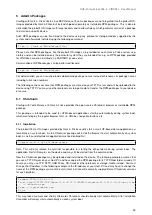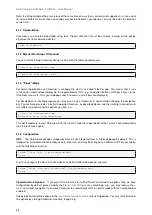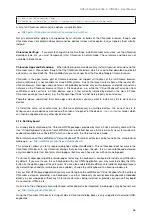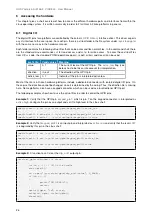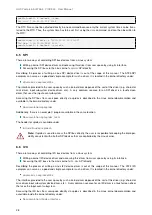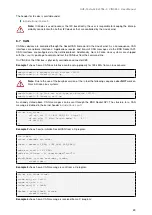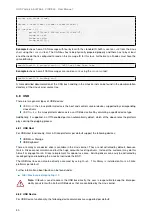
GUF-Yocto-34.0-r5756-0
VINCELL
User Manual
Note:
Due to the fact that telnet does not use encryption, it is recommended to deactivate this service
in final products in order to avoid security leaks. Disabling services is described in the chapter
[
I
.
The telnet service has a startup link that points to the corresponding start script:
/etc/rc.d/S20telnet -> /etc/init.d/telnet
The startup script simply starts
/usr/sbin/telnetd
as a daemon. The usage of telnetd is shown by executing:
root@vincell:~# telnetd --help
BusyBox v1.22.1 (2015-09-17 20:08:55 CEST) multi-call binary.
Usage: telnetd [OPTIONS]
Following options are available and configured directly in the start script
/etc/init.d/telnet
:
Options:
-l LOGIN
Exec LOGIN on connect
-f ISSUE_FILE
Display ISSUE_FILE instead of /etc/issue
-K
Close connection as soon as login exits
(normally wait until all programs close slave pty)
-p PORT
Port to listen on
-b ADDR[:PORT]
Address to bind to
-F
Run in foreground
-i
Inetd mode
-w SEC
Inetd 'wait' mode, linger time SEC
-S
Log to syslog (implied by -i or without -F and -w)
4.1.5 Module loading
The
modules
service is responsible for external module loading at system startup. It has a startup link that points
to the corresponding start script:
/etc/rcS.d/S05modutils.sh -> /etc/init.d/modutils.sh
The startup script simply looks which modules are listed in
/etc/modules
and loads them using
/sbin/modprobe
.
To ensure that the module loading works correctly, the module dependencies in
/lib/modules/<kernel ver-
sion>/modules.dep
have to be consistent.
4.1.6 Network initialization
The
network initialization
service is responsible for initializing all network interfaces at system startup. Garz &
Fricke systems use ifplugd to detect if an ethernet cable or an WLAN stick is plugged.
The network interfaces are listed on the target system in the configuration file
/etc/network/interfaces
. On
conventional Linux systems, the user configures the network interfaces by hand using this file. On Garz & Fricke
systems, there is a service called
sharedconf
as described in
[
I
4.1.7 Garz & Fricke shared configuration]
that
generates this file automatically according to the settings in the global XML configuration.
If the user wants to change the network settings, it is recommended to use the
sconfig
script as described in
[
I
4.2.1 Garz & Fricke system configuration]
.
Note:
Changes that are made to
/etc/network/interfaces
directly will be overwritten by the sharedconf
service on the next system startup and have no effect.
4.1.7 Garz & Fricke shared configuration
The
sharedconf
service reads shared configuration settings from the XML configuration and configures the
Linux system accordingly. This includes network (as described in
[
I
) and touch
configuration.
The sharedconf service has a startup link that points to the corresponding start script:
16






















